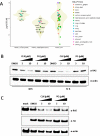Characterization of clinically used oral antiseptics as quadruplex-binding ligands
- PMID: 29481610
- PMCID: PMC5888870
- DOI: 10.1093/nar/gky084
Characterization of clinically used oral antiseptics as quadruplex-binding ligands
Abstract
Approaches to characterize the nucleic acid-binding properties of drugs and druglike small molecules are crucial to understanding the behavior of these compounds in cellular systems. Here, we use a Small Molecule Microarray (SMM) profiling approach to identify the preferential interaction between chlorhexidine, a widely used oral antiseptic, and the G-quadruplex (G4) structure in the KRAS oncogene promoter. The interaction of chlorhexidine and related drugs to the KRAS G4 is evaluated using multiple biophysical methods, including thermal melt, fluorescence titration and surface plasmon resonance (SPR) assays. Chlorhexidine has a specific low micromolar binding interaction with the G4, while related drugs have weaker and/or less specific interactions. Through NMR experiments and docking studies, we propose a plausible binding mode driven by both aromatic stacking and groove binding interactions. Additionally, cancer cell lines harbouring oncogenic mutations in the KRAS gene exhibit increased sensitivity to chlorhexidine. Treatment of breast cancer cells with chlorhexidine decreases KRAS protein levels, while a KRAS gene transiently expressed by a promoter lacking a G4 is not affected. This work confirms that known ligands bind broadly to G4 structures, while other drugs and druglike compounds can have more selective interactions that may be biologically relevant.
Figures




References
-
- Gottesfeld J.M., Neely L., Trauger J.W., Baird E.E., Dervan P.B.. Regulation of gene expression by small molecules. Nature. 1997; 387:202–205. - PubMed
-
- Janssen S., Durussel T., Laemmli U.K.. Chromatin opening of DNA satellites by targeted sequence-specific drugs. Mol. Cell. 2000; 6:999–1011. - PubMed
-
- Demeunynck M., Bailly C., Wilson W.D.. Small Molecule DNA and RNA Binders: From Synthesis to Nucleic Acid Complexes. 2003; Weinheim: Wiley-VCH.
-
- Shin Y.J., Kumarasamy V., Camacho D., Sun D.. Involvement of G-quadruplex structures in regulation of human RET gene expression by small molecules in human medullary thyroid carcinoma TT cells. Oncogene. 2015; 34:1292–1299. - PubMed
-
- Gunaratnam M., Cuenca F., Beltran M., Swank S., Fletcher J., Neidle S.. Targeting imatinib-resistant gastrointestinal stromal tumors by down-regulation of KIT gene expression with quadruplex-stabilizing small molecules. Mol. Cancer Ther. 2007; 6:3519s.
Publication types
MeSH terms
Substances
LinkOut - more resources
Full Text Sources
Other Literature Sources
Molecular Biology Databases
Miscellaneous

